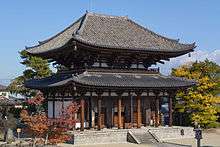Kikō-ji
Kikō-ji (喜光寺) is a Buddhist temple in Nara, Japan. Founded in the eighth century, its Muromachi-period Hondō and the Heian-period statue of Amida Nyorai enshrined within are Important Cultural Properties.
| Kikō-ji 喜光寺 | |
|---|---|
 Hondō, early Muromachi period (ICP) | |
| Religion | |
| Affiliation | Hossō |
| Deity | Amida Nyorai (Amitābha) |
| Location | |
| Location | 508 Sugawara-chō, Nara, Nara Prefecture |
| Country | Japan |
| Geographic coordinates | 34°41′05″N 135°46′40″E |
| Architecture | |
| Founder | Gyōki |
| Completed | 721 |
| Website | |
| http://www.kikouji.com/index.html | |
Name
Initially known as Sugawara-dera (菅原寺), the temple is said to have been renamed after a visit in 731 by Emperor Shōmu, when a wondrous ray of light shone forth from the brow of the honzon.[1][2]
History
Gyōki is said to have founded the temple in 721 and to have died there in 749. The Hondō was re-erected in the early Muromachi period. For a long time temple lay in the midst of rice fields.[1][2][3]
Buildings
The three by two bay Hondō, with tiled hipped roof and mokoshi, is unusual among wayō style buildings in being open, like the Tōdai-ji Daibutsuden, for its full height (without the need occasioned by the latter's daibutsu), in being so narrow and shallow relative to its height, and in having an open porch extending across its entire front. An early Muromachi period rebuild, it was dismantled for repair and reconstruction in 1933. It has been designated an Important Cultural Property.[2][4][5]
Treasures
In the Hondō are a seated wooden statue of Amida Nyorai dating from the Heian period (ICP), flanked by Kannon and Seishi of the Nanboku-chō period.[6][7]
See also
- For an explanation of terms concerning Japanese Buddhism, Japanese Buddhist art, and Japanese Buddhist temple architecture, see the Glossary of Japanese Buddhism.
References
| Wikimedia Commons has media related to Kikōji. |
- Augustine, Jonathan Morris (2005). Buddhist Hagiography in Early Japan: Images of Compassion in the Gyoki Tradition. Routledge. ISBN 978-0415322454.
- Soper, Alexander Coburn III (1942). The Evolution of Buddhist Architecture in Japan. Princeton University Press. pp. 247, 248, 255.
- "喜光寺の調査" [Survey of Kikōji] (PDF) (in Japanese). Nabunken. Retrieved 26 November 2015.
- Parent, Mary Neighbour (1983). The Roof in Japanese Buddhist Architecture. Weatherhill. pp. 188, 189, 284.
- 喜光寺本堂 [Kikōji Hondō] (in Japanese). Agency for Cultural Affairs. Retrieved 26 November 2015.
- 木造阿弥陀如来坐像 [Seated Wooden Statue of Amida Nyorai] (in Japanese). Agency for Cultural Affairs. Retrieved 26 November 2015.
- 喜光寺の仏様 [Buddhist Images of Kikōji] (in Japanese). Kikōji. Retrieved 26 November 2015.
External links
- (in Japanese) Kikō-ji